Last Updated on April 27, 2023
There’s another designer breed in town that is worth the hype – the Australian Labradoodle!
But with so many doodles out in the canine world, dog lovers have to be aware of the varieties! So before adding an Australian Labradoodle as a part of your family, take the time to learn about them.
Keep reading our guide to know if this is the right hybrid for you.
Quick Navigation
- 1 The Standard Australian Labradoodle at a Glance
- 2 Origin: The Australian Labradoodle History
- 3 What does an Australian Labradoodle Look Like?
- 4 The Characteristics and Personality of the Australian Labradoodle
- 5 How to Take Care of An Australian Labradoodle
- 6 Is An Australian Labradoodle a Healthy Dog?
- 7 Where Can I Buy or Adopt An Australian Labradoodle?
- 8 Exclusive Clubs Focused on Australian Labradoodles
- 9 Comparing the Australian Labradoodle to other Doodles
- 10 Why Should I Buy An Australian Labradoodle?
The Standard Australian Labradoodle at a Glance
We’ve put together a table below to give you a quick overview of the Australian Labradoodle.
| Breed Summary | Australian Labradoodle Quick Facts |
| Breed Purpose | Service Dog, Companion Dog |
| Breed Size | Small-to Large |
| Height | 21 to 24 inches (53 to 61 cm) |
| Weight | more than 45 lbs (20 kg) |
| Coat Type | Fleece-textured, wool-textured, straight or slightly wavy |
| Shedding | Low |
| Most Popular Coat Colors | Parti, white, apricot, chocolate, black, merle |
| Lifespan | 13 to 15 years |
| Temperament | Energetic, Playful, Smart |
| Energy | High |
| Exercise Needs | 30 to 60 minutes per day |
| Average Price | $1,000 and $3,000 |
Origin: The Australian Labradoodle History
It’s easy to say that the Aussie Labradoodle is the same as the Standard Labradoodle. That the only difference is you added the place it came from. But it’s not that simple.
That is why we’re going to dig deeper on what breeds make up this cutie!
It all started in 1989 when a woman who is blind needed a service dog. The problem is, her husband is allergic to dogs.
Wally Conron, the Breeding Manager for Guide Dog Services in Australia, started working on creating a canine that has the perfect temperament of a service dog and a hypoallergenic coat.
He mixed two purebred dogs that fit the description. He picked the hard-working Labrador Retriever and the non-shedding Standard Poodle. Hence the name Labrador-Poodle or Labradoodle.
After that success, Wally Conron wanted to develop the breed further.
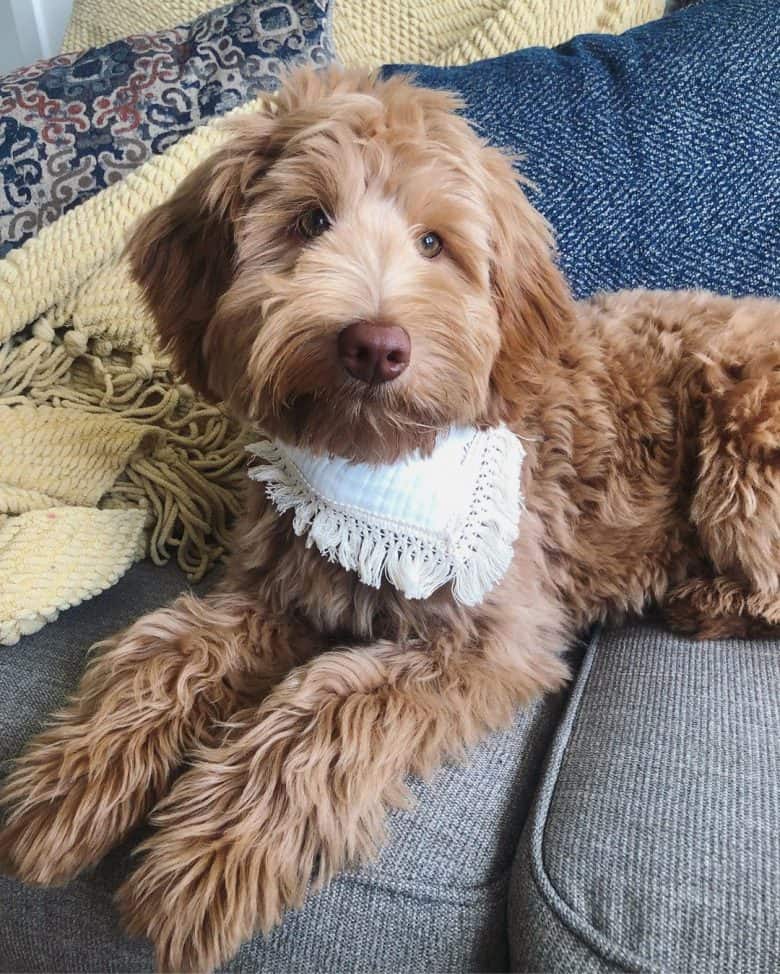
Australia’s Tegan Park and Rutland Manor helped by continuing what Wally started. They kept breeding Labradoodles to produce dogs that have consistent coat type, temperament, and conformation.
For us to understand how the developers were able to create the consistent qualities of this breed, we would need to discuss how the Australian Labradoodle was made.
What Makes an Australian Labradoodle?
An Australian Labradoodle can be classified as such if any of the 2 conditions is met:
- The Labradoodle breeding reached the 5th Generation
- The dog’s pedigree consists of the Labrador, Poodle, and American Cocker Spaniel
Unlike other crossbreeds that has two different purebred parents, the Aussie Labradoodle can be made up of three breeds, or be the result of the continuous breeding of Labradoodles.
Continuous breeding means you would have to cross two Labradoodles who both have Labradoodle parents as well. Once the puppies they produced are full grown, do that process five times (5 generations), and you would get the Australian Labradoodle, a multigenerational crossbreed. That is how they initially produced this breed.
And if you think that’s enough breeding to make this amazing dog, the organizations developing the Australian Labradoodle didn’t stop there. They knew that they could get more positive traits into the breed to make it perfect!
To do that, they carefully added other breeds into the Labradoodle lines that would bring in more desirable traits, and those dogs are the:
- Irish Water Spaniel
- Curly Coat Retriever
- English Cocker Spaniel
- American Cocker Spaniel
Add them up, including the Labrador and Poodle, then the Aussie Labradoodle have a total of 6 possible parental breeds.
All the parental breeds had something to bring to the table, but the most common mix used to create the Australian Labradoodle is the Poodle, Labrador Retriever, and the American Cocker Spaniel.
The developers of the breed often used the American Cocker Spaniel because it was the last dog they added to the Australian Labradoodle, and they saw that it brings in more consistent traits than the other dogs.
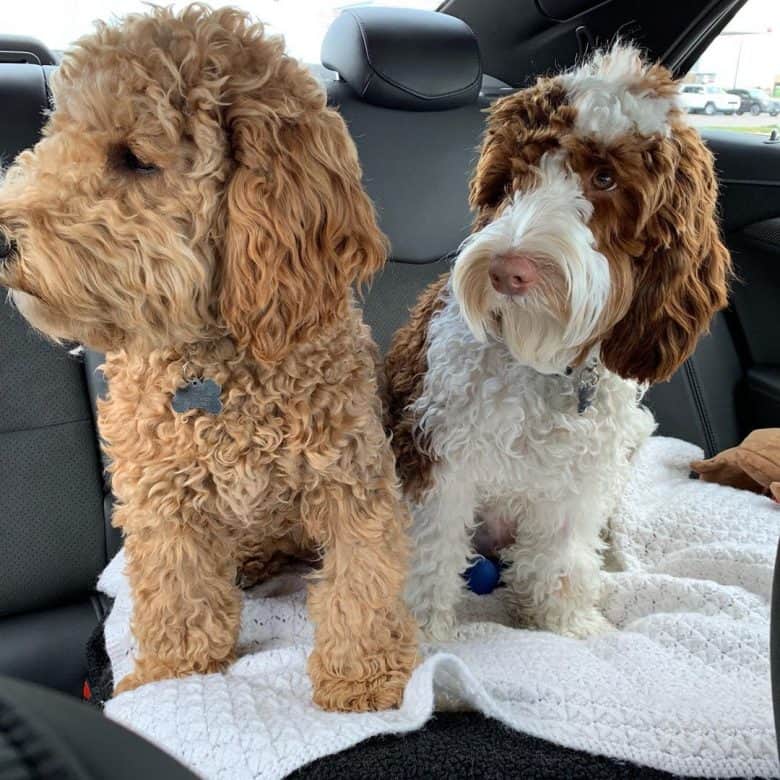
So let’s dive in and discuss the consistent attributes of this beautiful Doodle.
What does an Australian Labradoodle Look Like?
It’s a common saying that looks aren’t everything, but since we’re leaning towards the fact that Australian Labradoodles are merely perfect, their looks will complete your checklist.
They’re like adorable stuffed animals with big and round, dark brown eyes that will make you fall in love! Some of them even have eye colors that would range from dark amber to pale hazel-green eyes. And they have a large, square-shaped nose.
The Australian Labradoodle’s nose color can either be black, rose-colored, or rosy brown/pink, but it would vary depending on the hue of their coat.
Aussie Labradoodles have a square, stocky build, and has a tail that follows the topline when in motion but shouldn’t completely curl over the back.
How Big Is An Australian Labradoodle?
No matter where you live and how big or small your space is, you’re in luck! Since the Poodle parent comes in three sizes, so does the Aussie Labradoodle. All you have to do is pick!
Standard-sized Australian Labradoodles are about 21 to 24 inches (53 to 61 cm) tall and can weigh more than 45 pounds (20 kg).
Medium Australian Labradoodles are 17 to 20 inches (43 to 51 cm) tall and can weigh around 30 to 45 pounds (14 to 20 kg).
Miniatures are just the cutest! They are only 14 to 16 inches (36 to 41 cm) tall and will weigh just about 15 to 30 pounds (7 to 14 kg).
You have to keep in mind that males are usually larger than female dogs. But for better comparison, here is a chart showing the sizes of an Australian Labradoodle when fully grown:
| SIZE CHART | Height | Weight |
| Standard Australian Labradoodle |
21 to 24 inches |
more than 45 lbs |
| Medium Australian Labradoodle |
17 to 20 inches |
30 to 45 lbs |
| Miniature Australian Labradoodle |
14 to 16 inches |
15 to 30 lbs |
Since they are available in three sizes, an apartment or a home with an average-sized yard would be enough and suitable to make this dog happy. What matters is that they get their daily dose of physical and mental exercise.
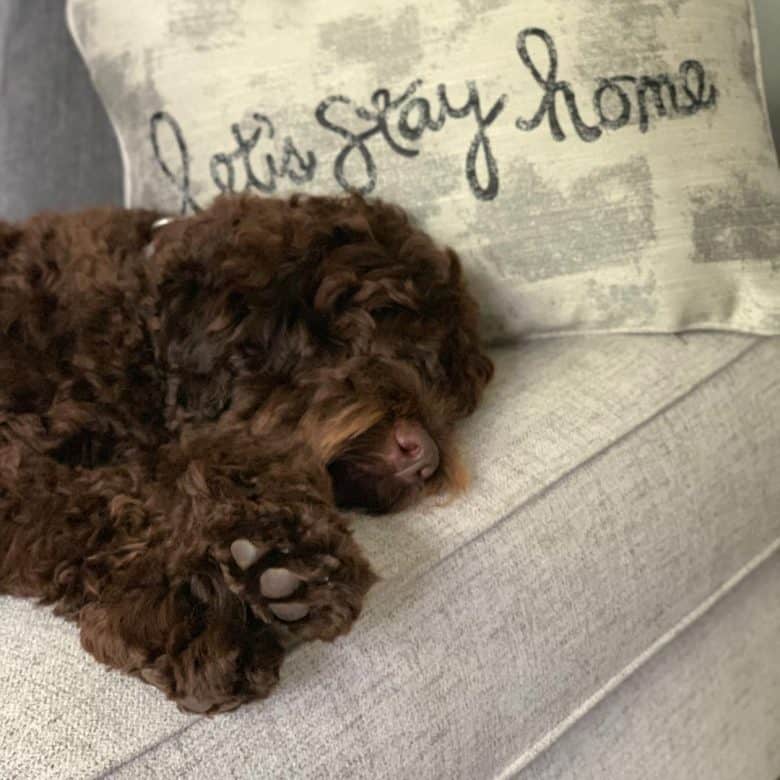
Australian Labradoodle Coat And Color
We know that this fluffy pooch looks like a perfect cuddle buddy candidate, but did you know that it has three different types of coats?
- Fleece-textured: These are silky soft and can range from an almost straight or open fleece to a wavy one.
- Wool-textured: Is like a lamb’s wool and has a cotton-like feel to the touch. It’s like a Poodle’s but has a looser spiral that opens up easily to the skin.
- Hair-coat type: Whether it’s straight or slightly wavy, the hair-type is coarse to the feel and may have that doggy odor. Even if you prefer your Doodle to be short-haired or long-haired, this type is a lower maintenance coat and has varying degrees of shedding.
Aussie Labradoodles also come in a wide variety of colors, such as the parti, white, apricot, chocolate, black, merle, and more!
If you decide to get an Australian Labradoodle puppy, don’t be surprised if his coat color changes. It will either darken or fade as he matures.
Grooming the Aussie Labradoodle’s Hypoallergenic Coat
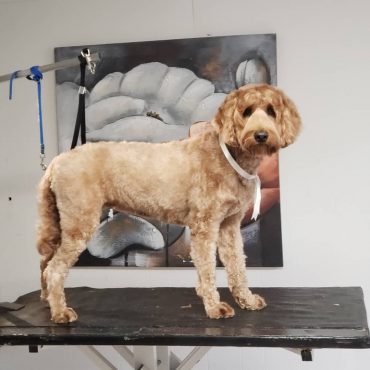
No matter what type of coat your Australian Labradoodle have, ask yourself first: “What kind of look do I want my dog to have?” and “How long do I want his coat to be?”.
Since the Australian Labradoodle’s coat have been continuously developed over the last 35 years, they are farther from getting the shedding trait of a Labrador.
But even though they’re a non-shedding breed, they still need regular grooming.
You can brush your Doodle’s coat twice a week to prevent matting, as well as to keep his fur healthy and clean. If your dog is mostly indoors, brushing every few days and an occasional bath would be enough.
Grooming sessions can also mean bonding time for you and your dog, but if you know you need professional help, remember to take him to the groomer every 2 to 3 months to keep an easy-to-maintain coat.
Just in case you’re wondering, the shaggy look is one of the most popular haircuts or look for Australian Labradoodles.
While we’re on the subject of grooming, don’t forget to trim your Australian Labradoodle’s nails every two to four weeks and brush his teeth monthly. For ears, do a monthly check and remove inner hair regularly to avoid infection due to lack of air flow.
Here’s a video showing basic grooming instructions for Australian Labradoodles by the ALAA:
The Characteristics and Personality of the Australian Labradoodle
Hands down, all dogs are fantastic! But did you know that a First Generation Labradoodle tends to be more hyperactive? Australian Labradoodles are far from that. They are calmer, balanced, intuitive, and mature. But they are still very fun to be around with, whether it’s indoor or outdoor play!
There’s also a reason why you’d hear and read a lot of good things about this breed, and it’s because of the good traits that it got from its parents.
Like the Poodle, Australian Labradoodles are very witty, agile, and friendly. They are a joy to be with because they can be pretty comical at times!
This breed would also be good for families with children. Just make sure to supervise your little kids whenever they’re around the puppy or your Mini Australian Labradoodle to avoid injuries.
Aside from that, Aussie Labradoodles are loyal, good with other dogs and pets, not afraid to show their affection and devotion, and are great guide and therapy dogs – just like their Labrador Retriever and Spaniel parents.
With all they can offer, how do you show your dog you love them? With proper care, of course!
How Much Exercise Does An Australian Labradoodle Need
Although this breed is suitable for all kinds of home, your dog still requires exercise to release his pent up energy from all those time spent indoors.
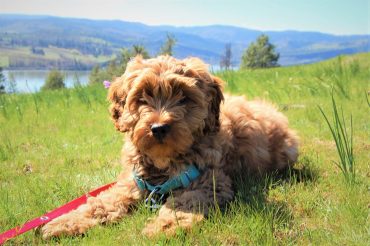
If your Aussie Labradoodle gets bored, unwanted behaviors may develop. What you need to do is keep him happy by providing lots of daily mental and physical activities.
The Australian Labradoodle has a high energy level, so 30 to 60-minutes of physical activities per day would be enough.
Aside from strolls, you can also take your dog to go jogging, running, hiking, or, if it’s your hobby, even hunting! Australian Labradoodles loves the water, too. If you have a pool, or if you live near a lake or the beach, bring him along, and you’d see him diving in to splash and swim.
If you don’t have time to take your dog out for a walk, a fenced backyard is a great setting to play fetch with him. This active game can easily fill 20 to 30 minutes of the required amount of exercise for an Aussie Labradoodle.
Aside from physical activities, your Doodle would also need mental stimulation. So providing him indoor entertainment such as chew, puzzle, or tug toys will challenge him intellectually.
Some of the popular products for this breed are the Kong Extreme and Outward Hound Nina Ottoson Dog Brick Treat Puzzle Dog Toy. Giving your Aussie Labradoodle several options would keep him from being bored, and it would also divert his attention from chewing on the furniture or your shoes.
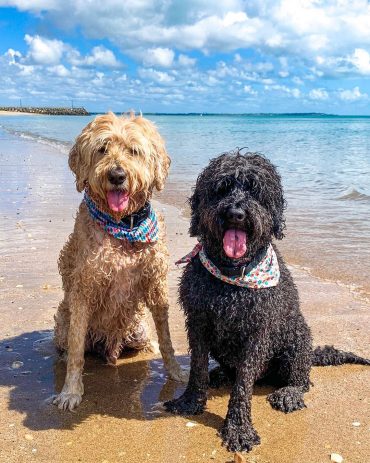
Training an Australian Labradoodle
One of the best things about this canine is that they are smart and easy to train. They can pick up your rules and the tricks you teach him in just a short amount of time.
WARNING! From the moment you bring your Australian Labradoodle puppy home, establish yourself as the pack leader of the house or the family. This breed could outsmart you and develop a rude attitude if he wasn’t raised, socialized, and appropriately trained.
Be the firm yet calm alpha and combat those behavioral issues with physical and mental exercise, and make sure you stick to a routine. Always keep your training sessions engaging and positive. You can do that by using treats, rewards, and praises to motivate any dog.
Be consistent and patient. If your dog or puppy wasn’t able to follow an instruction or made an accident on your favorite carpet, never use harsh tones or words, and be gentle. Negative experiences will never help.
Watch and listen to how this dog owner provide simple instructions/tricks while encouraging Teddy with treats and praises.
Let’s move on to the overall health of this amazing breed because not only do you have to feed your friendly canine’s mind and soul, but also the Aussiedoodles physical needs.
How to Take Care of An Australian Labradoodle
Australian Labradoodles have excellent qualities, but dog owners have more responsibilities than just taking their dog out for walks.
Aside from inheriting potential health problems from its parents, the Aussie Labradoodle comes in three sizes. That means you would have to pay attention to the specific needs of the Doodle you pick.
Simple things like avoiding your Mini Australian Labradoodle from jumping off furniture or going up and down the stairs can help prevent joint problems, or knowing how much to feed him, so he doesn’t get overweight. After all, the best thing you can do to show how much you love your pet is by taking care of him.
The Diet Suitable For Such An Active Dog
All dogs deserve a high-quality, species- and size-appropriate diet to make sure they stay healthy.
So before choosing a specific diet or dog food for your Aussie Labradoodle, ask your vet first to be sure about the meals’ amount and nutritional balance.
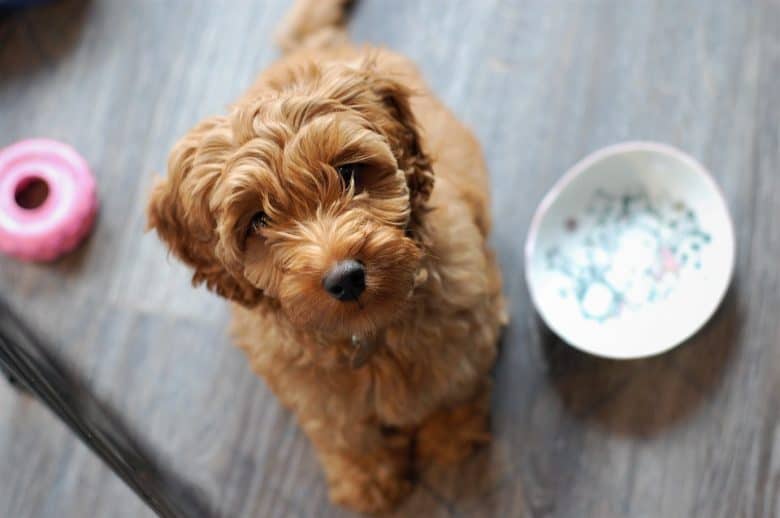
Give your Australian Labradoodle 2 1/2 to 3 cups of dog food every day and split it into two meals.
It’s up to you on what time you feed your dog, as long as he doesn’t get too hungry and it’s somehow consistent. What most owners do is feed their furry buddy once in the morning and once in the evening.
If you opt for a homemade or raw diet or even high-quality human-grade dog food, all you have to do is reduce the amount of dry food you give your fur buddy to prevent him from getting too fat.
If your Australian Labradoodle is overweight
A chubby dog can look cute, but you’d be putting your pet’s health at risk. If you think he’s getting overweight, you can split his daily 2 1/2 to 3 cups of dog food into three meals instead of the usual two.
And no matter how much your Australian Labradoodle beg with those loving eyes, don’t give him table scraps and human junk food.
Other things you can do to help him lose weight is changing to a low fat but high fiber dog food.
There are lots of food for canines that will help them lose the pounds while keeping their joints healthy since obesity can affect your dog’s mobility.
You should also stick to dog treats that are low in calories. Try providing fruits instead, like small pieces of apples or carrots.
For Australian Labradoodles who are underweight
Since we have Australian Labradoodles that can eat a lot, there are some dogs that doesn’t have that big of an appetite and can become underweight. It’s possible that your Doodle has been burning a lot of energy, but be sure that he is losing weight not because of an underlying illness.
If he is healthy despite being thin, you can help your pooch to gain weight. You can add another cup of dog food into his daily diet. So from 2 to 3 cups, you can make it into 4 and divide them into two or three meals a day.
You can also switch to a dog food that is intended for puppies instead of adults.
It means you don’t have to give your dog more cups because the increased calories is essential to ensure the adequate growth of puppies.
Keep a close watch at what and how much your Australian Labradoodle is eating. You can adjust the frequency of mealtimes and the quantity of food to see which works. And make sure that your pet gets plenty of exercise.
To know if your Doodle reached a healthy weight and is maintaining it, he should get a wellness exam every six to twelve months to avoid going back to being too thin or fat.
Is An Australian Labradoodle a Healthy Dog?
The Australian Labradoodle is generally a healthy breed, but no one can foresee all health concerns that can affect your designer dog.
All we can do is learn about this Doodle’s background and the parent’s possible health issues so we can be aware of them and hopefully, minimize or even avoid the chances of your pet getting any of it.
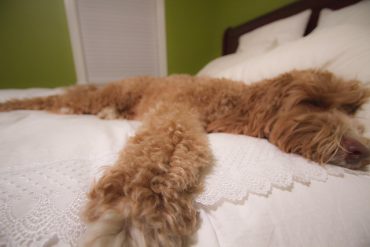
Crossbreeds inherit the most common health problems that affect their parents, and some of those that your Australian Labradoodle may get are:
- Patellar Luxation
- Progressive Retinal Atrophy
- Elbow and Hip Dysplasia
- Von Willebrand’s Disease
You should also observe if your Australian Labradoodle is often itching and scratching, which can be a sign that he has allergies.
One of the possible reasons behind it is that your Aussiedoodle may be allergic to a specific ingredient in his food such as grains or chicken. Not only can it lead to skin irritation, but also digestive issues.
You would also have to consider important factors such as your Doodle’s age and health conditions. Things like, the quantity of food that a puppy would need is different from how much you should give to an adult Australian Labradoodle.
You can always switch to hypoallergenic dog food or treat for your allergy-friendly Aussiedoodle. It will help manage, not only his coat and skin, but as well as his digestive health.
If your Doodle has eye discharge, proper care, and cleaning is the best way to deal with it. But if it appears green or any other color, make an appointment with your vet to have it checked.
Work and consult with a trusted veterinarian to keep your doodle as healthy as you can and maybe (fingers crossed) your Australian Labradoodle would exceed its average life expectancy of 13 to 15 years!
Now that we learned the important facts or information about the Australian Labradoodle, let’s move on to where you can get one.
Where Can I Buy or Adopt An Australian Labradoodle?
When mixed breeds are involved, you have to dig deeper whenever you do your research. You have to be extra careful when looking for a breeder that adheres to the standards of registered and reputable breeders.
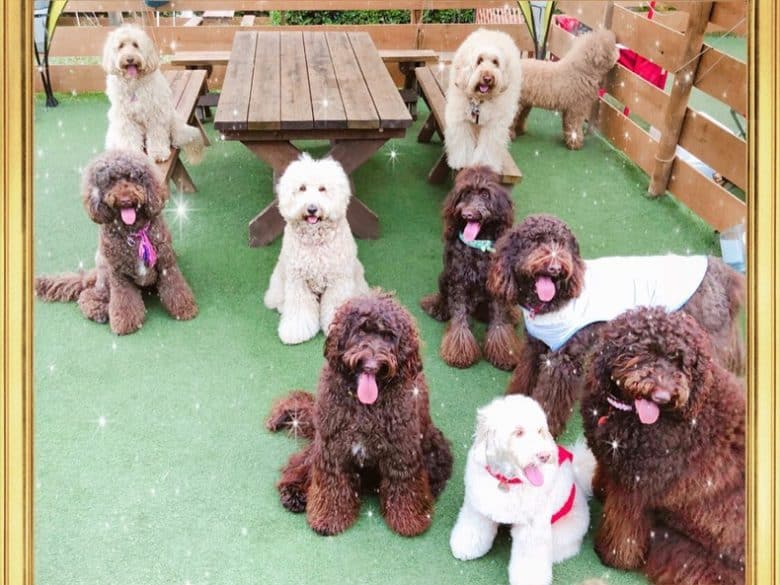
And when you decide to buy, make sure you’re purchasing from someone who doesn’t acquire Australian Labradoodle puppies from puppy mills.
You wouldn’t want to get involved in that and accidentally support them. Plus, there will be a big possibility that eventually, there would be a problem with your dog temperament-wise or their health.
How much does an Australian Labradoodle cost?
An Australian Labradoodle litter would usually have an average of 8 puppies, so they are not really that rare. But some of the factors that would affect the price would be the breeder, the lineage, and the location.
Generally, an Australian Labradoodle puppy would cost around $1,000 and $3,000.
Why are Australian Labradoodles expensive?
It’s not just because the Australian Labradoodle is a designer dog, but also because of the breeding stock.
If the breeder uses a higher generation of Doodle and does a lot more health testing on the parents, it would make sense that the Aussiedoodle is expensive.
Since the Aussiedoodle is not your average hybrid, breeders invest their time, dedication, and money to focus on producing this kind of dog.
And that what makes Australian Labradoodles worth your money. You’d be paying for a high-quality canine companion with consistent and amazing qualities.
Australian Labradoodle Breeders
If you want to buy an Aussie Labradoodle puppy, you can check out the member breeders of the Australian Labradoodle Association of America.
The Australian Labradoodle Club of America gives you an option to see their International, US, and Canada breeder members.
Aside from those, here are some of the other breeders online that focuses on the Labradoodle and Australian Labradoodle breed:
- Bunji Australian Labradoodles (Midwest Michigan, US)
- Archview Labradoodles (Illinois, US)
- High Country Australian Labradoodles (Keene, NH, US)
- Aussie Labradoodle (Columbus, Ohio, US)
- Lomond Hills Labradoodles (Scotland, UK)
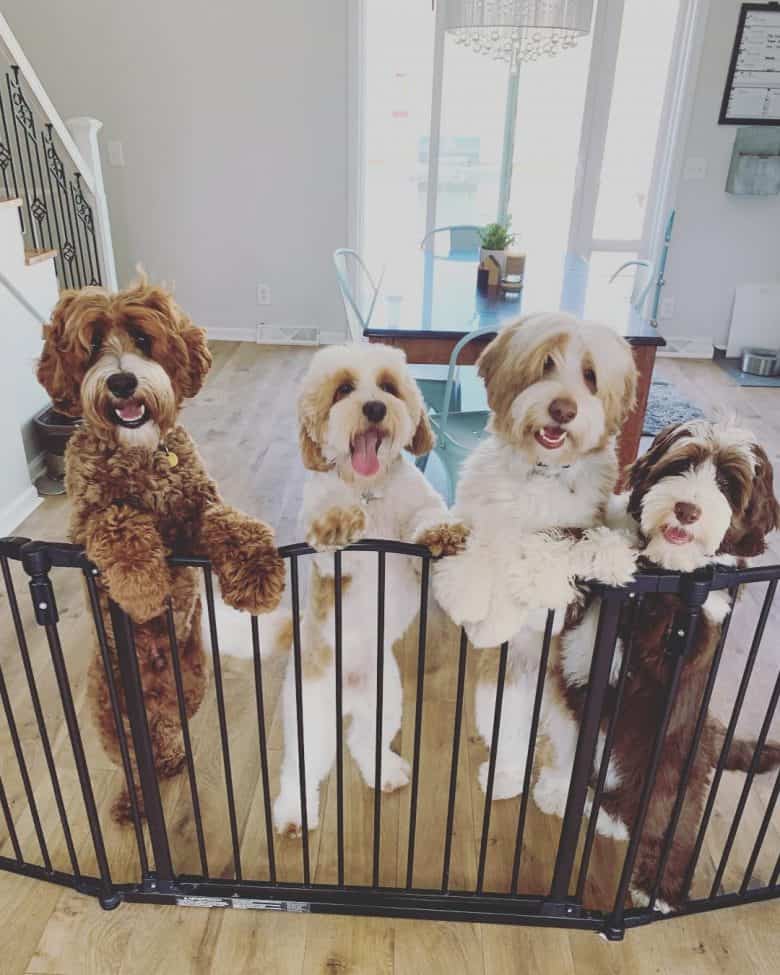
Adopting or Rehoming Australian Labradoodles
If you decided to adopt, rescue, or rehome an Australian Labradoodle, we support that 100%!
You will not just get a canine companion; you’re also saving that dog’s life.
Take a look at these websites that offers a lot of options for you:
- Sugar Pine Doodles (Amador County, California)
- Daisy Hill Labradoodles (Southern Oregon)
- Doodle Rock Rescue (Dallas, Texas)
- Hale’s Australian Labradoodles (Central California)
- Mountain Park Labradoodles (Portland)
Exclusive Clubs Focused on Australian Labradoodles
We mentioned that there are organizations or clubs that are working hard to protect and continue the development of the Australian Labradoodle lines, and making sure that breeding is followed carefully.
Those groups deserve to be acknowledged, and they are:
- LAA – Labradoodle Association of Australia
- IALA – International Australian Labradoodle Association
- ALCA – Australian Labradoodle Club of America
- WALA – Worldwide Australian Labradoodle Association
- ALAEU – Australian Labradoodle Association Europe
These clubs also study what dog breeds are worthy of being allowed to introduce carefully into selected lines.
And since the Australian Labradoodle is a hybrid or a designer dog, the American Kennel Club (AKC) does not recognize this breed, but the Dog Registry of America Inc (DRA) does.
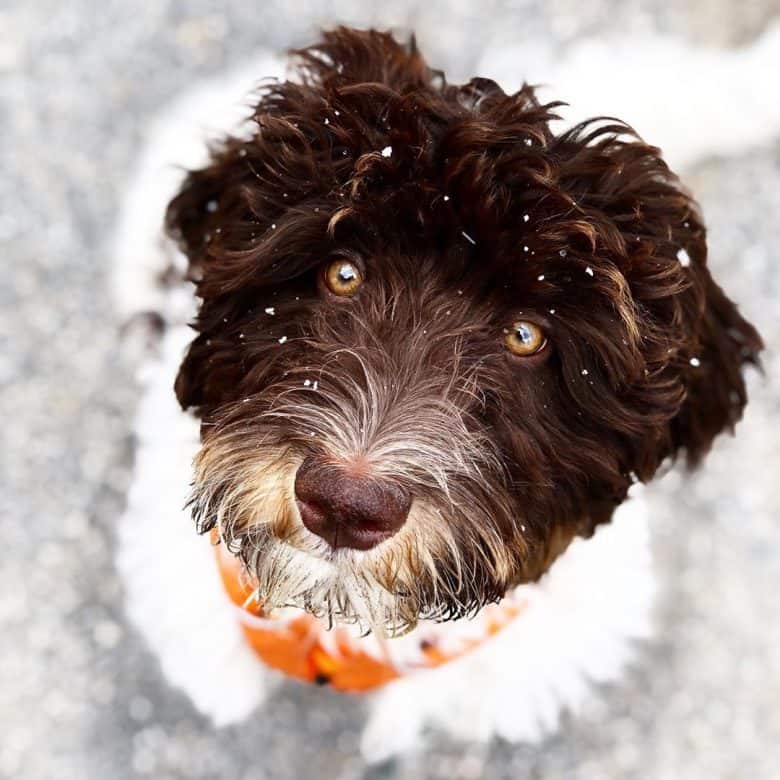
Comparing the Australian Labradoodle to other Doodles
Are you curious about the other Poodle mixes out there? Getting a quick look at their differences from the Australian Labradoodle would be very helpful.
It’s also a good thing to learn about the other varieties of Doodles because that means you’d have more options if you really like a breed that has been crossed with a Poodle.
Australian Labradoodle VS Standard Labradoodle
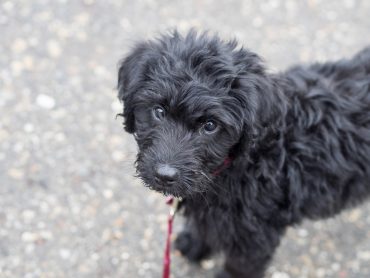
One of the differences between these two is that some Labradoodles do shed while Australian Labradoodles don’t, which makes them a popular choice for people with allergies.
Labradoodles are good family dogs but can be boisterous so an adult must supervise when they’re around kids.
If the Labrador-Poodle mix doesn’t get enough attention and exercise, they can develop behavioral issues such as barking or chewing. Australian Labradoodles are calmer, won’t act up when bored, and easier to train.
But Labradoodles are very affectionate and are great service dogs.
Australian Labradoodle VS Bernedoodles
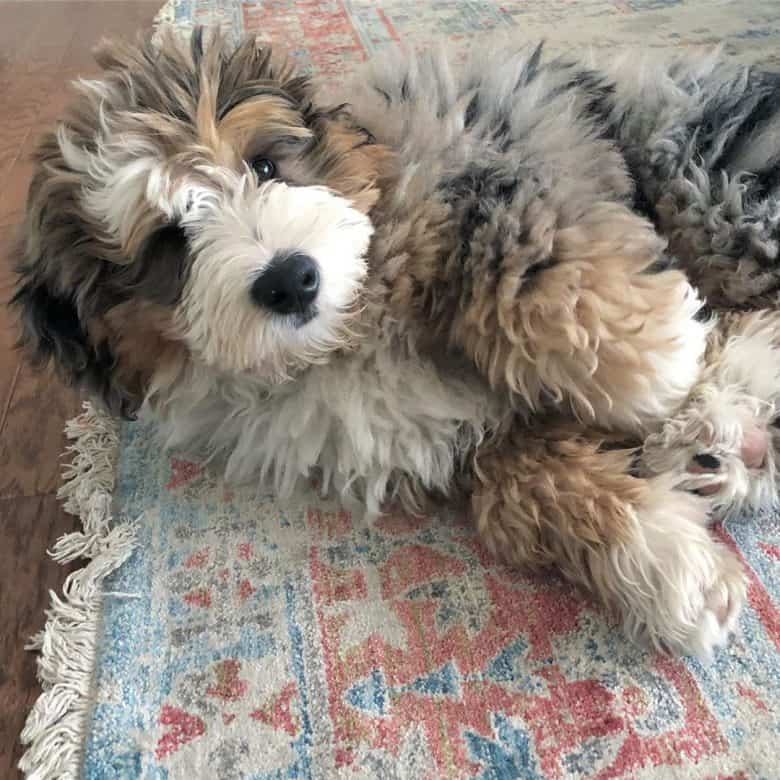
Like the Australian Labradoodles, Bernedoodles are calm and gentle. But Bernes can be stubborn during their puppyhood, and you can expect that attitude to go away as they mature.
Bernedoodles are also goofy and make an excellent family dog, but they may have trouble keeping up with an active family because their energy level is low.
They’re also not for small homes and can be aloof with strangers. Aside from that, they’re pretty easy going.
Australian Labradoodle VS Goldendoodles
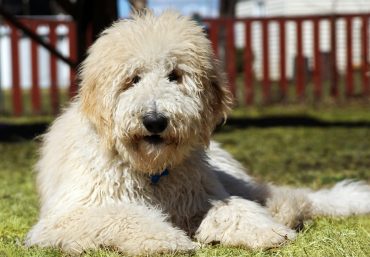
When it comes to temperament, the Goldendoodle is somewhat similar to the Australian Labradoodle.
Friendly, social, and affectionate, it’s no wonder they do great as a guide, service, or therapy dog. The Golden Retriever-Poodle mix is great with kids and pets and is easy to train.
Goldendoodles won’t do good if you leave it alone for long periods or if you don’t give it enough attention.
Australian Labradoodle VS Sheepadoodles
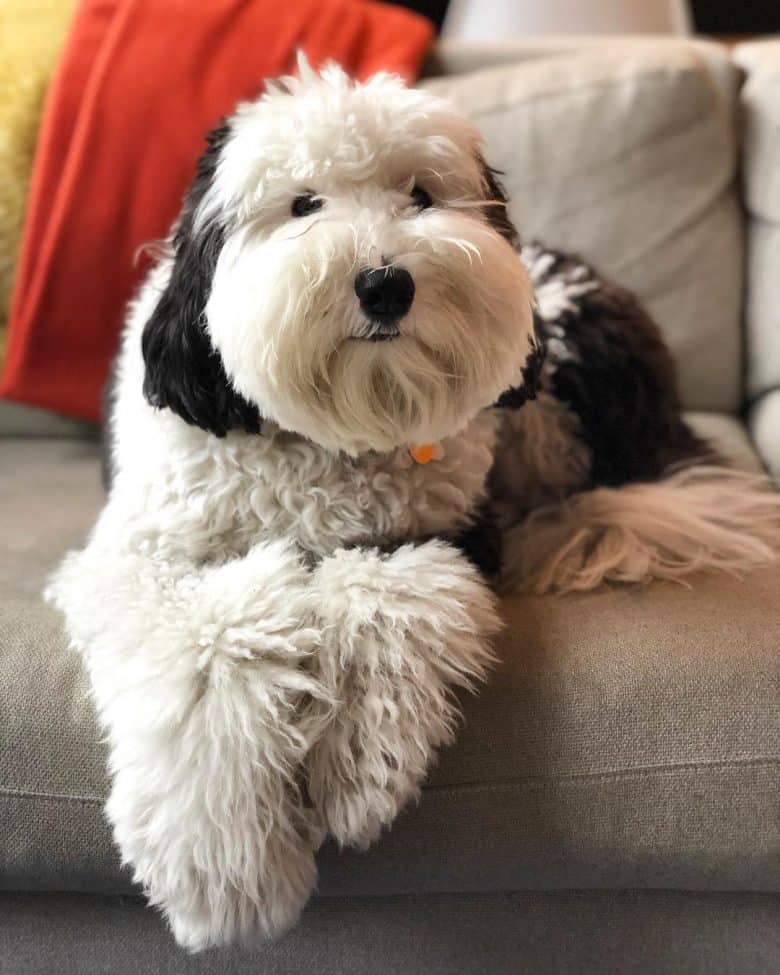
The Sheepadoodle is a breed that is also easy to train because they’re intelligent.
They’d do good in a family that has kids, but you’ve got to supervise.
This dog has not forgotten its herding trait and would try to do it to their playmates, and it might even nip!
Nevertheless, Sheepadoodles are cheerful and make a good watchdog.
Why Should I Buy An Australian Labradoodle?
Overall, this breed is perfect as it probably passed all the things that you have to look for when searching and choosing a dog: great temperament or personality, intelligence, consistency in conformation, and top-notch coat.
But of course, to reach a decision, you’d have to weigh in the pros and cons of having an Australian Labradoodle.
This Doodle is suitable for most homes and families, as well as for people who suffer from allergies – even those who prefer less mess and odor inside their homes.
The better coat types, which is the wool- and fleece-type, are prone to knots and matting though. So you and your Aussie Labradoodle would need to get used to a grooming routine.
And this dog needs a range of daily activities – from walking to running, and to chewing and thinking. If you’re always away due to work or you prefer spending your time indoors, then this canine who loves being on-the-go is not for you.
The Australian Labradoodle mix is a smart breed and can get the better of you with its cunning attitude. But early training and proving who’s the leader of the pack will let your Doodle know his place.
But overall, this breed is the most mild-mannered pooch you can wish for!
What do you think of the Australian Labradoodle? Let us know all about your stories and opinion regarding Aussie Labradoodles, and even share some tips or advice!
Type it all in the comments below and let others learn or just gush over your cute pet tales!
Cess is the Head of Content Writing at K9 Web and a passionate dog care expert with over 5 years of experience in the Pet Industry. With a background in animal science, dog training, and behavior consulting, her hands-on experience and extensive knowledge make her a trusted source for dog owners.
When not writing or leading the K9 Web content team, Cess can be found volunteering at local shelters and participating in dog-related events.

Thank you for providing this information. It was extremely helpful.
My 8 yr old aussidoodle ,Bella, has been very healthy, never chews furniture, super calm with thunder, firework and guns. Loves being outdoors but is a couch potato indoors. Very good alert/watch dog. Only bad trait, she fusses at us if we don’t respond to request to go out. She the best dog we have ever had. She does not meet stangers. Only dog I have had that will not run off. Worth every penny.